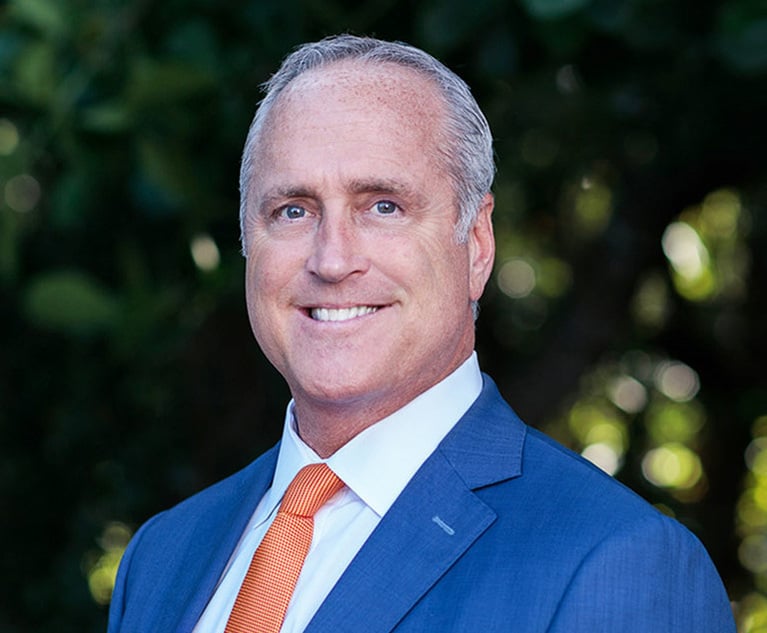DOL Issues Final Rule on Fluctuating Workweek Method of Calculating Overtime
The final rule, effective 60 days from the date of publication, provides much-needed clarification on this method of compensation that has confounded many employers and resulted in different interpretations by the courts.
June 04, 2020 at 09:36 AM
7 minute read
 Lindsay M. Massillon, left, and Elizabeth Pryor Johnson, right, of Fowler White Burnett.
Lindsay M. Massillon, left, and Elizabeth Pryor Johnson, right, of Fowler White Burnett.On May 20, the Department of Labor (DOL) announced its final rule on the fluctuating workweek (FWW) method of calculating overtime pay for nonexempt employees. The final rule, effective 60 days from the date of publication, provides much-needed clarification on this method of compensation that has confounded many employers and resulted in different interpretations by the courts. Significantly, the final rule expressly permits employers to pay bonuses and incentive compensation (premiums for working nights or productivity pay) to employees who are paid using the FWW method. Courts have disagreed as to whether such additional payments destroy the "fixed salary" requirement of the FWW method, exposing employers to additional liability for overtime violations under the Fair Labor Standards Act (FLSA). The final rule addresses the confusion created by the former 2011 final rule that did not adopt certain proposed language related to the payment of bonuses under the FWW method.
As noted by the DOL, the timing of this final rule is not unintentional: "[The final rule] is especially important as workers return to work during the COVID-19 pandemic. Some employers are likely to promote social distancing in the workplace by having their employees adopt variable work schedules, possibly staggering their start and end times for the day." The department believes that the changes to the regulation will make it easier for employers to be creative in scheduling, but also have the freedom to provide bonuses and incentives to employees (including hazard pay), without repercussion.
FWW Background: The FWW method is one way in which employers can choose to compensate nonexempt employees and is set out in 29 CFR Section 771.114. Given the confusion around the FWW method and inconsistent court rulings, many employers may not know that this is an option or may shy away from implementing this method with their employees. However, the FWW method—when done correctly—is a cost-effective way to compensate nonexempt employees who work over 40 hours in a workweek without running afoul of the FLSA. Using the FWW method can save an employer a significant amount in overtime premiums—and with the implementation of the final rule, much of the uncertainty has been eliminated.
In order to use the FWW method, the following are required: an employee's weekly hours must vary week to week; the employee must be paid a "fixed salary" per week that is meant to compensate straight time for all hours worked in the workweek; the fixed salary must be sufficient to provide compensation to the employee at a rate not less than the applicable minimum wage for all hours worked; there must be a clear mutual understanding between the employer and employee that the fixed salary is compensation (apart from overtime premium) for the hours worked in a workweek, no matter the amount; and the employee receives overtime compensation in addition to the fixed salary.
Variance in hours: There is a common misconception that this requirement means that the employee's hours must fluctuate both above and below 40. The final rule clarifies that the DOL has never meant this to be a requirement—only that the hours per week do vary.
Fixed Salary: There was confusion as to whether an employee could be paid a bonus or premium payments, yet still be on a "fixed salary." The final rule amends Section 711.114 to expressly permit such bonus payments, as well as to expressly allow for occasional disciplinary deductions from an employee's salary for willful absences or tardiness or for infractions of major work rules, so long as those deductions do not reduce the required minimum wage or overtime compensation.
Minimum wage: The DOL also addressed how employers should handle the occasional workweek where an employee's fixed salary did not cover minimum wage as required by the FWW method. This may occur when an employee works an unusually high amount of hours in a workweek yet receives the same fixed salary; thus dropping their regular rate below the minimum wage. It was not clear whether the regulations would permit an employer to supplement a fixed salary with an additional payment to the employee to cover the minimum wage without invalidating the FWW method. The DOL adopted language which confirms that such occasional payments are acceptable, so long as the employer could not have foreseen that the salary would not compensate the employee at least minimum wage for hours worked. The DOL's changes allow employers some flexibility should there be an abnormal week in their employee's work history.
Clear and mutual understanding: The DOL clarified that this requirement does not mean that the employee must understand exactly how their overtime is calculated or the precise payroll method used. See Garcia v. Yachting Promotions, 662 F. App'x 795, 797 (11th Cir. 2016) (per curium). The rule only requires that there is a clear and mutual understanding that while the employee's hours may vary, the base salary will not. See Valerio v. Putnam Associates, 173 F.3d 35, 40 (1st Cir. 1999). Thus, the DOL added language to Section 778.114(a) that the employee does not need to understand the specific method used to calculate overtime pay. While not required by the law we recommend that the employer put in writing that the employee will be compensated a fixed salary which is meant to cover the employee's regular pay for all hours worked, whether few or many.
The employee receives proper overtime compensation: The employer will need to calculate the proper overtime premium each week (as it will vary based on the number of hours worked). The final rule sets out several examples to demonstrate how the overtime premium should be calculated for an employee on a FWW method.
Example: The employee works varying hours each week and is paid $600/week with the understanding that it constitutes the employee's total compensation (excluding bonuses, overtime premiums, premium payments, etc.). In week one, the employee works 37.5, 44, 50, and 48 hours during the course of four weeks. Employee's regular rate of pay, therefore varies for each of these four weeks ($16, $13.64, $12, and $12.50 per hour respectfully). Because the salary covers straight time for all hours worked, The employer only needs to pay half time for hours worked over 40. Therefore, the employer would owe the employee $600 for the first week (salary, no overtime); $627.28 for the second week ($600 salary plus four hours of overtime with a half-time rate of $13.64 for a total overtime payment of $27.28); $660 for the third week ($600 salary plus 10 hours of overtime with a half-time rate of $6 for a total overtime payment of $60); and $650 for the fourth week ($600 salary plus eight hours of overtime with a half-time rate of $6.25 for a total overtime payment of $50).
Compare: The employee is nonexempt and receives $15/hour. Using the same hours worked as above, The employer would have paid the employee $562.50 for the first week ($37.50 less than FWW); $690 for the second week ($32.72 more than FWW); $825 ($165 more than FWW); and $780 ($130 more than FWW). Had Employer used the FWW method, Employer would have saved a total of $290.22 over the span of four weeks.
With the DOL's added clarification that bonus payments, shift premiums and the occasional deduction for certain absences/violations of major work rules do not invalidate the FWW, along with the other changes listed above, more employers may want to consider utilizing the FWW method of compensation for employees, whose hours vary during a workweek.
Elizabeth P. Johnson is a shareholder at Fowler White Burnett where she focuses her practice on all aspects of labor and employment law. Contact her at [email protected].
Lindsay M. Massillon is an associate at the firm where she focuses her practice on labor and employment law and commercial litigation. Contact her at [email protected].
This content has been archived. It is available through our partners, LexisNexis® and Bloomberg Law.
To view this content, please continue to their sites.
Not a Lexis Subscriber?
Subscribe Now
Not a Bloomberg Law Subscriber?
Subscribe Now
NOT FOR REPRINT
© 2025 ALM Global, LLC, All Rights Reserved. Request academic re-use from www.copyright.com. All other uses, submit a request to [email protected]. For more information visit Asset & Logo Licensing.
You Might Like
View All

Don’t Forget the Owner’s Manual: A Guide to Proving Liability Through Manufacturers’ Warnings and Instructions
5 minute read

Law Firms Mentioned
Trending Stories
Who Got The Work
J. Brugh Lower of Gibbons has entered an appearance for industrial equipment supplier Devco Corporation in a pending trademark infringement lawsuit. The suit, accusing the defendant of selling knock-off Graco products, was filed Dec. 18 in New Jersey District Court by Rivkin Radler on behalf of Graco Inc. and Graco Minnesota. The case, assigned to U.S. District Judge Zahid N. Quraishi, is 3:24-cv-11294, Graco Inc. et al v. Devco Corporation.
Who Got The Work
Rebecca Maller-Stein and Kent A. Yalowitz of Arnold & Porter Kaye Scholer have entered their appearances for Hanaco Venture Capital and its executives, Lior Prosor and David Frankel, in a pending securities lawsuit. The action, filed on Dec. 24 in New York Southern District Court by Zell, Aron & Co. on behalf of Goldeneye Advisors, accuses the defendants of negligently and fraudulently managing the plaintiff's $1 million investment. The case, assigned to U.S. District Judge Vernon S. Broderick, is 1:24-cv-09918, Goldeneye Advisors, LLC v. Hanaco Venture Capital, Ltd. et al.
Who Got The Work
Attorneys from A&O Shearman has stepped in as defense counsel for Toronto-Dominion Bank and other defendants in a pending securities class action. The suit, filed Dec. 11 in New York Southern District Court by Bleichmar Fonti & Auld, accuses the defendants of concealing the bank's 'pervasive' deficiencies in regards to its compliance with the Bank Secrecy Act and the quality of its anti-money laundering controls. The case, assigned to U.S. District Judge Arun Subramanian, is 1:24-cv-09445, Gonzalez v. The Toronto-Dominion Bank et al.
Who Got The Work
Crown Castle International, a Pennsylvania company providing shared communications infrastructure, has turned to Luke D. Wolf of Gordon Rees Scully Mansukhani to fend off a pending breach-of-contract lawsuit. The court action, filed Nov. 25 in Michigan Eastern District Court by Hooper Hathaway PC on behalf of The Town Residences LLC, accuses Crown Castle of failing to transfer approximately $30,000 in utility payments from T-Mobile in breach of a roof-top lease and assignment agreement. The case, assigned to U.S. District Judge Susan K. Declercq, is 2:24-cv-13131, The Town Residences LLC v. T-Mobile US, Inc. et al.
Who Got The Work
Wilfred P. Coronato and Daniel M. Schwartz of McCarter & English have stepped in as defense counsel to Electrolux Home Products Inc. in a pending product liability lawsuit. The court action, filed Nov. 26 in New York Eastern District Court by Poulos Lopiccolo PC and Nagel Rice LLP on behalf of David Stern, alleges that the defendant's refrigerators’ drawers and shelving repeatedly break and fall apart within months after purchase. The case, assigned to U.S. District Judge Joan M. Azrack, is 2:24-cv-08204, Stern v. Electrolux Home Products, Inc.
Featured Firms
Law Offices of Gary Martin Hays & Associates, P.C.
(470) 294-1674
Law Offices of Mark E. Salomone
(857) 444-6468
Smith & Hassler
(713) 739-1250






